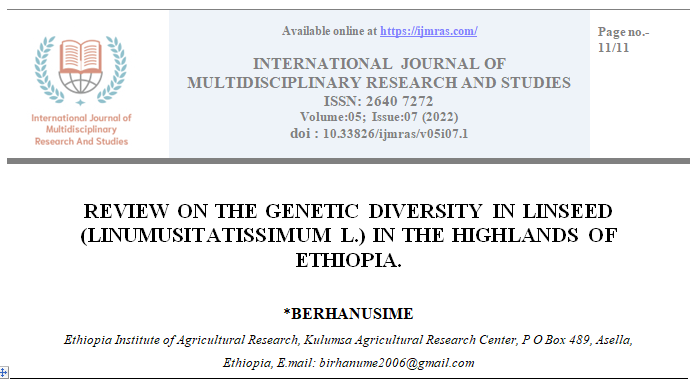REVIEW ON THE GENETIC DIVERSITY IN LINSEED (LINUMUSITATISSIMUM L.) IN THE HIGHLANDS OF ETHIOPIA.

Abstract
Linseed is a multipurpose crop grown for the production of stem fiber and seed oil. Linseed Domestication has been inferred genetically from neutral markers and increasingly from specific domestication–associated locus. However, some crops are utilized for multiple purposes that may or may not be reflected in a single domestication-associated locus. Due to long-term domestication for the fulfillment of these purposes, cultivated flax has diversified into two main types, namely fiber and oil or linseed types, as well as an intermediate type. These types differ considerably in morphology, growth habits, and agronomic traits. Fiber-type plants are usually taller and have fewer branches while linseed types are often shorter, have more branches, and produce more seeds. The center of origin of flax or Linseed (Linumusitatissimum L.) is uncertain. It is considered that L. Bienne is the progenitor of small-seeded flax, originating from Kurdistan and Iran, Flax or Linseed is indigenous to the region expanding from the eastern Mediterranean to India, and was presumably first domesticated in the Fertile Crescent. Flax is an annual plant growing 120 cm tall, with slender stems. The leaves are green, 20-40 mm long and 3 mm broad. The flowers are majorly pure pale blue and of various other colors, 15-25 mm in diameter, with five petals.
Keywords
Linseed, Diversity,, origin, Importance, fiber.How to Cite
References
Kajalsamantara, sourav ranjan mohapatra and pradhan, b. D. 2020. Assessment of genetic diversity in linseed (linumusitatissimum l.). Int. J. Curr. Microbial. App. Sci. 9(05): 508-513. Doi: https://doi.org/10.20546/ijcmas.2020.905.057
Janakinath dash, b. S. N. A. U. B. M. (2017). "linseed: a valuable crop plant." international journal of advanced research (ijar) 5(3): 1428-1442.
Dinsayadetadabalo , b. C. S. S., bulchaweyessa (2020). "genetic variability and association of characters in linseed (linumusitatissimum l.)Plant grown in central Ethiopia region." Saudi journal of biological sciences 27 (2020) 2192–2206.
Tamirumeleta, r. D., kissiwakweya (2018). "assessment of linseed (linumusitatissimum l.)Yield loss due to weed in sinana, highland condition of the bale, south-eastern Ethiopia." scientific journal of pure and applied sciences 7(1): 729-734.
Yechalewsileshi, m. H., behailuatero, abushtesfaye (2019). "linseed (linumusitatissimum l.)Variety adaptation at southwestern Ethiopia." international journal of forestry and horticulture (ijfh) 5(4, 2019, pp 41-45): 5.
BIRHANUAMAREGIDEY, K. K. A. N. K. (2020). "YIELD EVALUATION AND CHARACTER ASSOCIATION OF LINSEED (LINUMUSITATISSIMUM L.) GENOTYPES IN MOISTURE STRESS AREAS OF SOUTH TIGRAY, ETHIOPIA." JOURNAL OF CEREALS AND OILSEEDS 11(1): 16-20.
Vijayatripathi, a. B. A., s. Markerb, s.bilalc (2013). "linseed and linseed oil: health benefits- a review." international journal of pharmacy and biological sciences 3(3): 434-442.
Singh, k. K., mridula, d., rehal, j., and barnwal, p. (2011). Flaxseed: a potential source of food, feed, and fiber. Crit. Rev. Food sci. Nutr. 51, 210– 222.doi: 10.1080/10408390903537241
Liu, f.-h., Chen, x., long, b., Shuai, r.-y., and long, c.-l. (2011). Historical and botanical evidence of distribution, cultivation, and utilization of linumusitatissimum l. (flax) in china.veget. Hist. Archaeobot. 20, 561–566. Doi: 10.1007/s00334-011-0311-5
Diederichsen, a., and Ulrich, a. (2009). Variability in stem fiber content and its association with other characteristics in 1177 flax (linumusitatissimum l.) Genebank accessions.ind. Crops prod. 30, 33–39. Doi: 10.1016/j.indcrop.2009.01.002
Oomah, b. D. (2001). Flaxseed is a functional food source. J. Sci. Food Agri. 81, 889–894. Doi: 10.1002/jsfa.898
Juitadlugogorski, b. Z., Kennedy, e. M., and mackie, j. C. (2012). Low-temperature oxidation of linseed oil: a review. Fire sci. Rev. 1:3. Doi: 10.1186/2193-0414-1-3
Deyholos, m. K. (2006). Bast fiber of flax (linumusitatissimum l.): biological foundations of its ancient and modern uses. Israel j. Plant sci. 54, 273–280. Doi: 10.1560/ijps_54_4_273
Naik, s., goud, v. V., rout, p. K., Jacobson, k., and Dalai, a. K. (2010). Characterization of Canadian biomass for alternative renewable biofuel. Renew. Energy 35, 1624–1631. Doi: 10.1016/j.renene.2009.08.033
You, f. M., Duguid, s. D., lam, i., cloutier, s., rashid, k. Y., and booker, h. (2016b). Pedigrees and genetic base of the flax varieties registered in Canada. Can. J. Plant sci. 96, 837–852. Doi: 10.1139/cjps-2015-0337
Worku, n., Heslop-Harrison, j. S., and adugna, w. (2015). Diversity in 198 Ethiopian linseeds (linumusitatissimum) accessions based on morphological characterization and seed oil characteristics. Genet. res. Crop Evol. 62, 1037–1053. Doi: 10.1007/s10722-014-0207-1
Foulk, j. A., akin, d. E., dodd, r. B., and Frederick, j. R. (2004). Optimizing flax production in the south Atlantic region of the USA. J. Sci. Food Agri. 84, 870–876. Doi: 10.1002/jsfa.1738
Tutin, t.g., Heywood, v.h., burgers, n.a., murre, d.m., valentine, d.h., walters, s.m. and Webb, d.m. (ed.). 1968. Flora Europaea: Rosaceae to Umbelliferae. Cambridge Univ. Press, Cambridge. Uk.
Zohary, d. And hopf, m. 1993. Domestication of plants in the old world.the origin and spread of cultivated plants in West Asia, Europe, and the Nile valley.2nd edition. Oxford science publications, Clarendon press, oxford. Isbn.
Muravenko, o.v., amosova, a.v., samatadze, t.e., popov, k.v., poletaev, a.i. and zelenin, a.v. 2003. 9- aminoacridin- an efficient reagent to improve human and plant chromosome banding patterns and standardize chromosome image analysis. Cytometry a. 51: 52–57.
Gill, k.s., 1987. Linseed. Indian council of agricultural research, new Delhi, India. pp. 386.
Anonymous, 1996. Growing flax: production, management, and diagnostic guide, 3rd edn. Flax Council of Canada, Winnipeg.
Freeman, t. P. 1995. Structure of flaxseed, in flaxseed in human nutrition, Champaign, aocs press, pp. 11-21.
Bunting, a.h. 1951. Linseed. Paint manufacturing 21: 444-447.carter, j. F. 1993. Potential of flaxseed and flaxseed oil in baked goods and other products in human nutrition. Cereal foods world .38(10):753-759.
Diederichsen, a. 2001. Comparison of genetic diversity of flax (linumusitatissimum l.) Between Canadian cultivars and a world collection. Plant breeding 120(4): 360-362.
Diederichsen, a. And fu, y.b. 2006. Phenotypic and molecular (rapid) differentiation of four infraspecific groups of cultivated flax (linumusitatissimum l. Subp. Usitatissimum ). Genet resource crop evol53 (1): 77–90.
License
Copyright (c) 2022 BerhanuSime

This work is licensed under a Creative Commons Attribution 4.0 International License.
Individual articles are published Open Access under the Creative Commons Licence: CC-BY 4.0.



